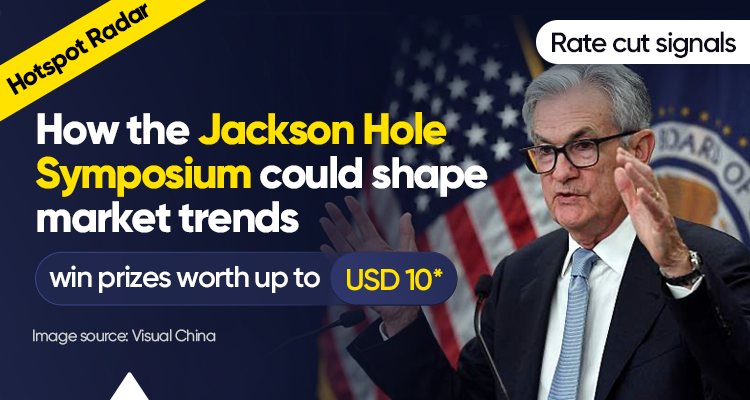
The Jackson Hole Central Bank Annual Meeting is a significant event in the global financial market, drawing substantial attention from investors.
Federal Reserve Chairperson Powell's speech is expected to be the highlight, with the market eagerly anticipating insights into the future direction of monetary policy.
Why did the Federal Reserve gather in Jackson Hole?
The Jackson Hole Central Bank Annual Meeting, first held in 1978, originally focused on agricultural economy issues. However, since 1982, when then-Federal Reserve Chairperson Paul Volcker attended, the event has evolved into a key platform for global central bank leaders to exchange views on macroeconomic policies and discuss global economic trends.
What makes Jackson Hole particularly significant for investors is that speeches by the Federal Reserve chairperson and other central bank leaders often provide crucial insights into the future direction of monetary policy.
Conference topics and market expectations
The theme of this year's Jackson Hole Annual Meeting is "Reassessing the Effectiveness and Transmission Mechanism of Monetary Policy."
Federal Reserve Chairperson Jerome Powell's speech will be the highlight of this year's meeting. Market participants are particularly interested in whether Powell will provide hints about the future policy direction of the Federal Reserve, especially regarding the pace of interest rate cuts.
Additionally, leaders from other major central banks, including the European Central Bank, the Bank of England, and the Bank of Japan, will also deliver speeches, and their insights are worth noting. The uneven global economic recovery and the policy differences among countries may lead to varied interpretations of central bank policies in the market, potentially influencing the volatility of global asset prices.
Is Powell's speech difficult to predict?
Federal Reserve Chair Jerome Powell is set to deliver a keynote speech at 10:00 am GMT+8 on August 23. The market widely anticipates that Powell will use this opportunity to offer insights into the Fed's future monetary policy direction, particularly regarding potential interest rate cuts.
Predictions on Powell's speech
Despite the high market expectations for a rate cut, many Wall Street analysts believe Powell may not provide a clear signal. Instead, his speech is likely to focus on assessing the current state of the US economy, with particular attention to inflation and employment data. The market will closely analyze Powell's tone and choice of words for any subtle hints, rather than relying on explicit statements.
Potential market reactions:
Confirmed rate cut: If Powell confirms a rate cut, the market is expected to react positively. Rate cuts are generally seen as supportive of economic growth, as they reduce borrowing costs and encourage consumption and investment. This could lead to a rise in the stock market, especially in interest rate-sensitive sectors like real estate and consumer goods. Additionally, bond prices might increase, yields could fall, and the US dollar might depreciate against other currencies.
No rate cut or ambiguity: Conversely, if Powell indicates that the Fed does not plan to cut rates immediately or fails to provide a clear signal, the market may react negatively, potentially triggering a broad sell-off in equities. This would suggest that the Fed views the current monetary policy as appropriate or that inflation concerns outweigh worries about economic growth. Such a stance could put pressure on the stock market, particularly in sectors sensitive to interest rate changes, while the US dollar might strengthen, and the bond market could face selling pressure.
Investment opportunity and risk analysis
After the Jackson Hole annual meeting, global markets may face increased volatility as expectations shift toward potential interest rate cuts by the Federal Reserve.
Stock market
If Powell indicates that the Fed may cut interest rates soon, it could signal support for economic growth, leading to a rise in the stock market, particularly in technology and consumer sectors sensitive to interest rates. Lower financing costs generally boost corporate profits and stock prices. Conversely, if Powell expresses concerns about the economic outlook, the market may interpret this negatively, resulting in heightened volatility in the short term.
2. Bond market:
Expectations of interest rate cuts typically lead to rising bond prices, as a lower interest rate environment makes existing bond yields more attractive. In particular, long-term Treasury yields may decline further, boosting bond prices. However, if the market begins to worry that interest rate cuts indicate the risk of slowing economic growth, it could trigger risk aversion, increasing demand for bonds and driving yields lower.
3.Foreign exchange market:
Expectations of interest rate cuts typically weaken the dollar, as lower interest rates make it less attractive to investors. In contrast, other currencies like the euro and yen may strengthen, particularly if the European Central Bank or the Bank of Japan does not follow suit. However, if major economies cut interest rates simultaneously, the foreign exchange market could experience more complex interdependencies and reactions.
4. Commodities:
Expectations of interest rate cuts are generally positive for safe-haven assets like gold. As the US dollar weakens and interest rates fall, gold becomes more attractive, potentially driving up its prices. Additionally, interest rate cuts may stimulate economic activity, increasing demand for industrial commodities like crude oil. However, if the market interprets interest rate cuts as a signal of slowing economic growth, commodity prices may be negatively impacted.
*T&Cs apply. This is not financial advice. This advertisement has not been reviewed by the Monetary Authority of Singapore.